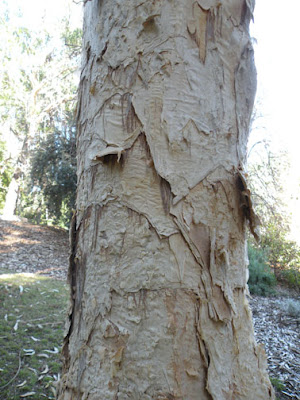The garden - started in 1929 - has undergone many changes over the years under different Directors and has been widely used for experimentation in growing tropical trees and plants. For instance, it was one of the first places in LA to grow different varieties of Eucalyptus trees. In 1971 it was given Mildred E. Mathias' name, she having been a long-term Director and a botanical pioneer, researching into and introducing new flowers and trees to the country- as well as being an early environmentalist.
It is wonderful to find yourself stepping off the road and suddenly plunging into this exotic world. How lucky UCLA students are to have this shady refuge on their doorstep. What a delightful place to- as I did- have a picnic lunch...
One of the first trees I came across was in fact another Rainbow Eucalyptus- Eucalyptus deglupta- but the bark of this one was, at this time, more subdued than the ones I had been photographing on the street:

Another beautiful Eucalyptus there was a Eucalyptus grandis, or Rose Gum:

And when I first entered the garden I got really excited by a grove of Eucalyptus maculata- or Spotted Gum- the patterns of their peeling bark being like a black-and-grey version of the London Plane tree:


And then I discovered another Eucalyptus, with a very different bark- Eucalyptus botryoides, or Southern mahogany:


This next tree could not be mistaken for a Eucalyptus! It is an Agonis flexuosa, or Willow myrtle:

Now I come to a tree that astonished me: it is yet another variety of Ficus tree, Ficus racemosa, or Cluster Fig. What amazed me was the way the figs grow out of the bark instead of on the ends of branches. To me, they looked as if they were the work of a Designer, who had scattered them onto the surface of a tree for a shop window display!



And here is another Ficus- Ficus gnapthalocarpa, or Sandpaper Fig. This time it was the geometric pattern of the bark that caught my eye:

It was the crazily peeling bark that attracted me to this next tree too- a Melaleuca styphelioides, or Prickly Paperbark:


I am always fascinated by Palm trees bark formations, however often I see them. First, a Brahea armata, or Blue Hesper Palm:

Secondly, a Butia capitata, or Jelly Palm:

Arriving down at the bottom of the hollow, beside a stream was this collection of Bamboos. When I first looked at them, I was upset that they had been so covered in name carvings- then it occurred to me that they actually looked like some wonderful Egyptian sculpture- or the spines of antique, leather-bound books. Sad as it was that they had not been respected as living organisms, at least they were still beautiful...

Here are some more- uncontaminated- bamboos:

And here is a group of the many Turtles that bask in the sun on the shores of the stream:

Finally, I took a look up into the sky, to the tops of Palm trees and Dawn Redwoods:


I have only mentioned the particular trees that caught my eye, but there is so much more to see- it is well worth a visit...



2 comments:
am delighted to have found your blog [via Patricia Powell Kessler]
and I am delighted to have found your blogs...
Post a Comment